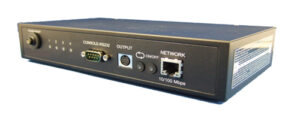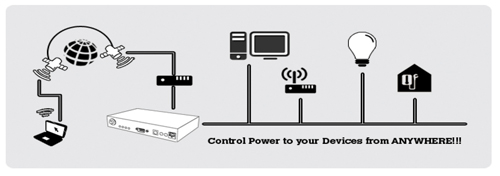 The IP Remote Power Management (IPRM-4S) is a 4 Port Power Distribution Unit (PDU) and Remote Power Control (RPC) system available in the UK via QED, which allows you to control and reset a power supply. Alternatively, set the timer to reboot at a certain date and time. It is particularly useful when you need to restart an unresponsive server that is in a remote site or location thus avoiding inefficient call out journeys.
The IP Remote Power Management (IPRM-4S) is a 4 Port Power Distribution Unit (PDU) and Remote Power Control (RPC) system available in the UK via QED, which allows you to control and reset a power supply. Alternatively, set the timer to reboot at a certain date and time. It is particularly useful when you need to restart an unresponsive server that is in a remote site or location thus avoiding inefficient call out journeys.
The product does not need to be connected to a PC/Monitor. With its built-in web server simply connect the IPRM-4S to a router using a Cat5E ethernet cable and then access the interface remotely through a web browser. It uses international standard IEC 320 Inlet/Outlet connectors.
This device has an email function that can be used in various scenarios and conditions. When a power port is activated or deactivated, the device will send an email. When the scheduler is used, the device will also send emails when ports are activated or deactivated, allowing you to monitor the time and date of your device status which changes directly within your email.
When connected to the network, this unit can be used to control four individual mains power supplies, to various items of equipment that may, periodically, require resetting using the “three pin reset” technique (i.e. pull the plug out), but doing it using the network. The maximum output rating is a total of 10 A each means that you could run each of the four outputs each at a nominal 575W (2.5A), the maximum output from any individual output is 6A according to the PDF Handbook, however the label on the unit itself gives the maximum individual output 8A.
Interestingly, the manual shows images of the rear panel with the four outlets and the text showing indicates outwards total of 15A.
One could argue that there should never be a need for equipment to be remotely power cycled, in that this always implies a failing of the system either in hardware or software terms. However, we live in the real world and we do indeed have situations where this type of equipment is necessary, plus you may have a need to just be able to remotely switch on equipment and this product therefore fills a niche.
It comes in its cardboard box with a mini CD containing the PDF manual. Do you need anything else? Yes an input power lead would be useful. The unit we had to test did not come with one, although the manual page 7 line 8 says “Please use the 10A Power lead provided that the mains input..” (Sic), implies that we should have had one. Thankfully the IEC lead needed is a commonly available type.
 The CD did not auto run and we could not find the Auto Run.html file on the CD. The IPEdit.exe file was run and the device was found on the network. The factory default IP address is shown on page 9 of the manual, as 192.168.10.100, which we found to be incorrect. Having carried out a factory reset the IP address that was then showing in the QED IPEdit window was actually 192.168.1.100, which meant for us it was necessary to reset the IP address of the laptop (having preset it to 192.168.10.1) to enable it to communicate with the IPRM4-S.
The CD did not auto run and we could not find the Auto Run.html file on the CD. The IPEdit.exe file was run and the device was found on the network. The factory default IP address is shown on page 9 of the manual, as 192.168.10.100, which we found to be incorrect. Having carried out a factory reset the IP address that was then showing in the QED IPEdit window was actually 192.168.1.100, which meant for us it was necessary to reset the IP address of the laptop (having preset it to 192.168.10.1) to enable it to communicate with the IPRM4-S.
Once you get over the frustrations of the “inaccuracies” of the manual, there are some useful features, such as the Auto Ping and time scheduling (with timing set via an NTP clock service) for power cycling or just simple on and off. The Auto Ping is useful in that if you have a slightly unreliable router, then if it is powered via the IPRM 4 – S, then if communication with the router is lost i.e. and has locked up, it will then automatically repower and reset the router.
The unit can also wake-up automatically (and turn the power on) on the LAN when it is sent a message on the LAN.
Score: 7 out of 10

